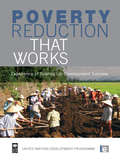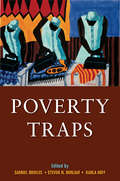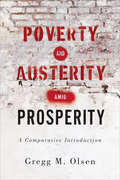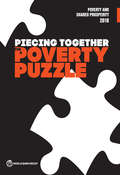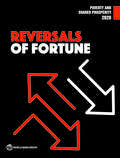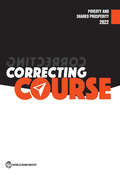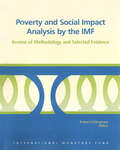- Table View
- List View
Poverty Reduction Strategies in Africa: The Ideology Of The Family-state (Global Africa)
by Toyin Falola and Mike O. OdeyA fundamental question about contemporary Africa is why does Africa remain so poor, long after the departure of the European Colonial domination and in the midst of so many natural resources? Poverty Reduction Strategies in Africa provides new understandings of the persistent issue of poverty in Sub-Saharan Africa and makes recommendations for policy frameworks to help African governments alleviate poverty. Each chapters uses case studies to review the old strategies for resolving the problem of poverty in the continent and make the case for new initiatives to address poverty. The contributors focus on practical and day-to-day issues as the best approach to formulate and implement poverty reduction strategies in contemporary Africa. This book is invaluable reading for students and scholars of African politics and development.
Poverty Reduction Support Credits: An Evaluation of World Bank Support
by World BankThis evaluation examines the relevance and effectiveness of Poverty Reduction Support Credits (PRSCs), introduced by the Bank in early 2001 to support comprehensive growth, improve social conditions, and reduce poverty in IDA countries. PRSCs were intended to allow greater country-ownership, provide more predictable annual support, exhibit more flexible conditionality, and strengthen budget processes in a results-based framework. By September 2009, the Bank had approved 99 PRSCs totaling some $7.5 billion and representing 38% percent of IDA policy based lending. The evaluation finds that in terms of process, PRSCs were effective in easing conditionality, increasing country ownership and aid predictability, stimulating dialogue between central and sectoral ministries, and improving donor harmonization. In terms of content, PRSCs succeeded in emphasizing public sector management and pro-poor service delivery. Yet in terms of results, it is difficult to distinguish growth and poverty outcomes in countries with PRSCs from other better performing IDA countries. There is scope for further simplifying the language of conditionality and underpinning PRSCs with better pro-poor growth diagnostics. PRSCs can also strengthen their results frameworks and limit sector policy content in multi-sector DPLs to high-level or cross-cutting issues. Today, Bank policy has subsumed PRSCs under the broader mantle of Development Policy Lending and the rationale for a separate 'brand name' although differences linger from the past. Since PRSCs and other policy-based lending have gradually converged in design, remaining differences compared to other Development Policy Loans should be clearly spelled out, or the separate PRSC brand name should be phased out.
Poverty Reduction and Changing Policy Regimes in Botswana (Developmental Pathways to Poverty Reduction)
by Onalenna SelolwaneAn examination of how Botswana overcame the legacies of exceptional resource deficiency and colonial neglect, to transform itself from one of the poorest nations of the world to a middle income economy. Contributions review how economic, social and institutional policies interacted to produce successful poverty reduction.
Poverty Reduction for Inclusive Sustainable Growth in Developing Asia (Economics, Law, and Institutions in Asia Pacific)
by Naoyuki Yoshino Farhad Taghizadeh-Hesary Nisit PanthamitThis book provides practical policy recommendations that are useful for developing Asia and for accelerating poverty reduction plans in the rest of the world. Poverty reduction in all its forms remains one of the greatest challenges facing humanity. In developing Asia, rapid growth in countries and sub-regions such as China, India, and Southeast Asia has lifted millions out of poverty, but progress has been uneven. On the other hand, the current coronavirus (COVID-19) pandemic and the global economic recession that it has caused are pushing millions of people back into poverty. Poverty reduction, inclusive growth, and sustainable development are inseparable, and poverty reduction is the premise for sustainable development. The Sustainable Development Goals (SDGs) are a bold commitment to finish what we started and end poverty in all forms and dimensions by 2030. However, because of the current global recession, the world is not on track to end poverty by 2030. Given the aforementioned situation, if we plan to achieve the no-poverty target in line with the SDGs, governments need to reconsider their policies and economies need to allocate their resources for this aim. Owing to the importance of the topic, this book provides several thematic and empirical studies on the roles of small and medium-sized enterprises, local businesses and trusts, international remittances and microfinance, energy security and energy efficiency in poverty reduction, and inclusive growth.
Poverty Reduction in China: Achievements, Experience and International Cooperation (International Research on Poverty Reduction)
by Lei Wang Houkai WeiThis book provides a systematic overview of China's achievements in eliminating absolute poverty by 2020 under current standards. The book is divided into three parts: The first part is a study of major policy practices with distinctive characteristics in China's poverty alleviation practices; the second part is a study of China's international cooperation in poverty alleviation; the third part is a study of China's poverty alleviation by international scholars from the perspective of international cooperation and international comparison. These reports pay attention to China's achievements and experiences in poverty alleviation and reflect on how to strengthen cooperation with China in poverty alleviation.
Poverty Reduction of the Disabled: Livelihood of persons with disabilities in the Philippines
by Tatsufumi Yamagata Soya Mori Celia M ReyesA third of poor people are disabled in the developing world. How much do we know about their livelihood with hard data? Are they entirely powerless and dependent on family members? How do they earn income? These questions have become more important than ever, now that persons with disabilities (PWDs) in developing countries have awakened to rights and entitlements and that the international community started considering the incorporation of disability into the context of poverty reduction. This book highlights opportunities and challenges faced by PWDs in the developing countries. This book also illustrates the analyses with a case study which was conducted in the Philippines and this case study has made a good progress in legislation for PWDs. A field survey was jointly conducted by the Institute of Developing Economies, Japan, and the Philippine Institute for Development Studies in Metro Manila, the capital city of the Philippines, in 2008. Around 400 PWDs were interviewed, and the data was investigated with econometrics. The book highlights a remarkable disparity in earnings and education among PWDs. The book also examines the positive role of organizations such as Disabled People’s Organizations and how empowerment of PWDs is made through dissemination of useful information such as programs given by the central and local governments. The book concludes that all measures, i.e. education, training, DPOs and institutional preferences, must be mobilized harmoniously to boost the livelihood of PWDs sinking in the bottom stratum in income.
Poverty Reduction of the Disabled: Livelihood of persons with disabilities in the Philippines
by Tatsufumi Yamagata Soya Mori Celia M. ReyesA third of poor people are disabled in the developing world. How much do we know about their livelihood with hard data? Are they entirely powerless and dependent on family members? How do they earn income? These questions have become more important than ever, now that persons with disabilities (PWDs) in developing countries have awakened to rights and entitlements and that the international community started considering the incorporation of disability into the context of poverty reduction. This book highlights opportunities and challenges faced by PWDs in the developing countries.This book also illustrates the analyses with a case study which was conducted in the Philippines and this case study has made a good progress in legislation for PWDs. A field survey was jointly conducted by the Institute of Developing Economies, Japan, and the Philippine Institute for Development Studies in Metro Manila, the capital city of the Philippines, in 2008. Around 400 PWDs were interviewed, and the data was investigated with econometrics. The book highlights a remarkable disparity in earnings and education among PWDs. The book also examines the positive role of organizations such as Disabled People’s Organizations and how empowerment of PWDs is made through dissemination of useful information such as programs given by the central and local governments.The book concludes that all measures, i.e. education, training, DPOs and institutional preferences, must be mobilized harmoniously to boost the livelihood of PWDs sinking in the bottom stratum in income.
Poverty Reduction that Works: Experience of Scaling Up Development Success
by Paul Steele Neil Fernando Maneka Weddikkara�This book provides an excellent framework to analyse the experience of a wide variety of successful initiatives across the world and draws attention to critical issues that practitioners need to think about when designing poverty reduction interventions and scaling up.� Bill Tod, Regional MDG Adviser, SNV Asia �With its wide regional coverage, and frank discussions of issues and problems encountered in designing projects that directly tackle poverty, this will be a very useful reference book for NGOs, INGOs, and also for multilateral institutions.� Johanna Boestel, Country Economist, Asian Development Bank, Sri Lanka Resident Mission We are now at the midpoint for achieving the Millennium Development Goals and the objective of halving poverty by 2015. Despite commendable efforts and much progress, up to 750 million people are still living in absolute poverty. To lift these people out of poverty, macro-economic policies must be complemented by targeted and local level poverty reduction. This book looks at twenty of the most innovative case studies of poverty reduction and Millennium Development Goal localization from fifteen countries - Afghanistan, Bangladesh, Cambodia, China, Egypt, India, Indonesia, Malaysia, Mexico, Nepal, Paraguay, Philippines, Sri Lanka, Thailand and Vietnam - covering diverse issues ranging from housing and tourism to socio-economic empowerment of women, health insurance and markets for livestock produce. Many of the cases started as small scale interventions by NGOs, donors or government pilots but now they are being scaled up to form part of national policy or replicated across their respective countries. Yet why do some work while others do not? What are the stumbling blocks and how can they be overcome? And what lessons and principles are there for replicating and scaling up poverty reduction initiatives worldwide? This book tackles these questions and more, and presents a wealth of knowledge, evidence and ideas for all practitioners and researchers working to reduce poverty at the local level while aiming to achieve a global impact. Published with UNDP
Poverty Traps
by Samuel Bowles Steven N. Durlauf Karla HoffMuch popular belief--and public policy--rests on the idea that those born into poverty have it in their power to escape. But the persistence of poverty and ever-growing economic inequality around the world have led many economists to seriously question the model of individual economic self-determination when it comes to the poor. In Poverty Traps, Samuel Bowles, Steven Durlauf, Karla Hoff, and the book's other contributors argue that there are many conditions that may trap individuals, groups, and whole economies in intractable poverty. For the first time the editors have brought together the perspectives of economics, economic history, and sociology to assess what we know--and don't know--about such traps. Among the sources of the poverty of nations, the authors assign a primary role to social and political institutions, ranging from corruption to seemingly benign social customs such as kin systems. Many of the institutions that keep nations poor have deep roots in colonial history and persist long after their initial causes are gone. Neighborhood effects--influences such as networks, role models, and aspirations--can create hard-to-escape pockets of poverty even in rich countries. Similar individuals in dissimilar socioeconomic environments develop different preferences and beliefs that can transmit poverty or affluence from generation to generation. The book presents evidence of harmful neighborhood effects and discusses policies to overcome them, with attention to the uncertainty that exists in evaluating such policies.
Poverty and Austerity amid Prosperity: A Comparative Introduction
by Gregg M. OlsenPoverty and Austerity amid Prosperity puts a sharp focus on rising levels of poverty and homelessness in Canada, the United Kingdom, and the United States. Highlighting the important differences between these countries, Gregg M. Olsen examines how poverty and homelessness have been conceptualized, defined, measured, and addressed in each country. Olsen critically contrasts the two main theoretical traditions – individual and societal – that have emerged to explain poverty and homelessness. Ultimately, he argues that societal approaches to the study of poverty are better equipped to explain the developments unfolding across these nations and that the eradication of poverty will only happen when the socioeconomic system has been seriously overhauled and founded upon economic democracy.
Poverty and Climate Change: Restoring a Global Biogeochemical Equilibrium (Routledge Studies in Sustainable Development)
by Fitzroy B. BeckfordMost, if not all of the global biogeochemical cycles on the earth have been broken or are at dangerous tipping points. These broken cycles have expressed themselves in various forms as soil degradation and depletion, ocean acidification, global warming and climate change. The best proposal for an organic solution to fixing the myriad broken cycles is a deliberate investment in solutions that first acknowledge the historic roles played by both the subjugated peoples, and the economic beneficiaries of the environmental exploitations of the past. Ever since Europeans made contact with the West, a series of global circumstances including the genocide of the indigenous people of the Americas, the enslavement and global subjugation of Africans, and the emergence of Western concepts of trade dominance and capitalism, have led to deleterious impacts on the global biogeochemical cycles. Addressing the broken biogeochemical cycles should be done with a clear understanding that it was not only human subjects which were subjugated, but also land, water, and air. These three global stores must be replenished from the ideological position that poverty is not simply the absence of money, but is also the lack of access to non-polluting energy sources, to clean air devoid of runaway greenhouse gasses, and to local conditions devoid of climate change instabilities. With this in mind, the global powerbrokers can enter into a new deal with developing nations, shifting the paradigm toward a new ecological approach that rewards good behavior and sets new standards of worldwide relations based on ecologic inclusivity rather than the exclusive economic arrangements currently in order. Harnessing a forward thinking approach to analyzing the current global environmental crisis, this book will be of great interest to students and scholars of sustainable development, political ecology, sustainable agriculture, climate change and environmental justice.
Poverty and Discrimination
by Kevin LangMany ideas about poverty and discrimination are nothing more than politically driven assertions unsupported by evidence. And even politically neutral studies that do try to assess evidence are often simply unreliable. In Poverty and Discrimination, economist Kevin Lang cuts through the vast literature on poverty and discrimination to determine what we actually know and how we know it. Using rigorous statistical analysis and economic thinking to judge what the best research is and which theories match the evidence, this book clears the ground for students, social scientists, and policymakers who want to understand--and help reduce--poverty and discrimination. It evaluates how well antipoverty and antidiscrimination policies and programs have worked--and whether they have sometimes actually made the problems worse. And it provides new insights about the causes of, and possible solutions to, poverty and discrimination. The book begins by asking, "Who is poor?" and by giving a brief history of poverty and poverty policy in the United States in the twentieth century, including the Welfare Reform Act of 1996. Among the topics covered are the changing definition of poverty, the relation between economic growth and poverty, and the effects of labor markets, education, family composition, and concentrated poverty. The book then evaluates the evidence on racial discrimination in areas such as education, employment, and criminal justice, as well as sex discrimination in the labor market, and assesses the effectiveness of antidiscrimination policies. Throughout, the book is grounded in the conviction that we must have much better empirical knowledge of poverty and discrimination if we hope to reduce them.
Poverty and Exclusion in North and South: Essays on Social Policy and Global Poverty Reduction (Priorities for Development Economics)
by Paul Mosley Elizabeth DowlerOver the past decade there has been a worrying increase in poverty in the industrialised countries of the "North", while many of the developing countries of the "South" have experienced some improvement. This collection argues that there are a number of likenesses between the predicaments of North and South, and that these warrant further investigation and analysis.
Poverty and Exclusion in the Western Balkans
by Caterina Ruggeri Laderchi Sara SavastanoThis book maps the latest developments in the policy relevant analysis on poverty, inclusion and the social agenda in the Western Balkans. It does so by presenting a selection of recent papers which explore from a methodological and analytical point of view how the inclusion agenda can be monitored and adapted to understand the challenges in the region. The volume includes an overview and four sections, covering respectively: (1) innovations in terms of measurement of poverty and inclusion in the region (the concept of inclusion as elaborated at the EU level, innovations in survey design to suit the measurement of inclusion, methodological insights from qualitative work); (2) innovative country level analysis (updating poverty mapping in inter-censual years, the analysis of material deprivation, the analysis of determinants of social inclusion, subjective wellbeing of public work programs participants); (3) examples of country level analysis of drivers of exclusion (barriers to formalization in the labour market, gender disparities in the labour market, disruption in social networks following urbanizations, attitudes towards multi-ethnic states); (4) building inclusive safety nets (an assessment of safety nets in the region, the political economy of welfare reform, micro-simulations of social assistance reform, the adoption of better tools to improve targeting performance). The chapters combine sophisticated techniques which are at the frontiers of poverty analysis (small area estimation, efficiency analysis applied to household welfare, micro-simulations) with less ground-breaking papers which take advantage of innovative datasets or perspectives deeply grounded in the policy dialogue in the countries of the region. By providing a wide spectrum of innovative and policy relevant analytical contributions this book will be of broader interest than for observers of the region.
Poverty and Inequality among Chinese Minorities (Routledge Studies on the Chinese Economy)
by Shufang Qiu Ajit S. BhallaThe number of poor people in China is huge, despite recent economic advances. The minorities in China constitute less than ten per cent of the entire population, yet they represent forty to fifty per cent of the absolute poor. This compelling book investigates the problem of poverty and inequality in and among Chinese ethnic minorities, focusing in particular on two important questions: Have the minorities shared the fruits of spectacular economic growth in China during the past two decades? Is their backwardness due to ethnic and cultural factors or to extremely low incomes? The authors examine the different factors explaining poverty, the relationship between poverty and ethnicity, poverty indicators that permit a comparison between minorities and non-minorities (or the Han majority), economic and demographic characteristics of minorities and their educational, occupational and gender profiles. They consider whether special measures in favour of minorities introduced by the Chinese government have contributed to an improvement in their standard of living. Poverty and Inequality among Chinese Minorities gives original research findings and new thinking on a highly topical issue in Chinese development economics, and fills a gap in the existing economic literature.
Poverty and Progress: An Ecological Model of Economic Development (Routledge Revivals)
by Richard G. WilkinsonOriginally published in 1973 and now reissued with a new Preface, this striking book challenges the whole structure of our thinking on how societies develop – why some are primitive and others advanced. It demonstrates that the pursuit of progress is not the real driving force behind change. Economic development, it argues, is simply the escape route of societies caught in the ecological pincers of population growth and scarce resources. The author explains the processes by which industrialization is forced upon societies by the progressive scarcity of all land-based resources. The things we think of as the fruits of man's search for progress including increasingly sophisticated technology, labour-saving machinery and the rest - are in fact part of the struggle to keep up with the growing productive task created by ecological pressures. ln this light primitive societies appear less poor than we imagine, and advanced ones less rich.
Poverty and Quality of Life in the Digital Era: Interdisciplinary Discussions and Solutions (SpringerBriefs in Well-Being and Quality of Life Research)
by Nikolaos E. MyridisThis book proposes new solutions to the problem of poverty, and begins with providing analyses. It bases most of the analyses and solutions in the context of the digital era. The book also follows, in addition to a scientific distribution, a spatial-geographical one: analyses of countries of the European Union as well as South Africa, while it referring to two main variables, television and art, as agents of poverty alleviation. The book places particular focus on how poverty is understood in the framework of Industry 4.0. It introduces a new expanded Multidimensional Poverty Index with more than 20 dimensions; moreover, it provides a mathematically based solution for the disposal of perishable food. Finally, it does not disregard the crucial aspect of the issue of poverty: that of education planning. This book is of interest to specialists in poverty research, from students to professionals and from professors to activists, without excluding engineers.
Poverty and Shared Prosperity 2016: Taking on Inequality
by World Bank GroupPoverty and Shared Prosperity 2016 is the first of an annual flagship report that will inform a global audience comprising development practitioners, policy makers, researchers, advocates, and citizens in general with the latest and most accurate estimates on trends in global poverty and shared prosperity. This edition will also document trends in inequality and identify recent country experiences that have been successful in reducing inequalities, provide key lessons from those experiences, and synthesize the rigorous evidence on public policies that can shift inequality in a way that bolsters poverty reduction and shared prosperity in a sustainable manner. Specifically, the report will address the following questions: * What is the latest evidence on the levels and evolution of extreme poverty and shared prosperity? * Which countries and regions have been more successful in terms of progress toward the twin goals and which are lagging behind? * What does the global context of lower economic growth mean for achieving the twin goals? * How can inequality reduction contribute to achieving the twin goals? * What does the evidence show concerning global and between- and within-country inequality trends? * Which interventions and countries have used the most innovative approaches to achieving the twin goals through reductions in inequality? The report will make four main contributions. First, it will present the most recent numbers on poverty, shared prosperity, and inequality. Second, it will stress the importance of inequality reduction in ending poverty and boosting shared prosperity by 2030 in a context of weaker growth. Third, it will highlight the diversity of within-country inequality reduction experiences and will synthesize experiences of successful countries and policies, addressing the roots of inequality without compromising economic growth. In doing so, the report will shatter some myths and sharpen our knowledge of what works in reducing inequalities. Finally, it will also advocate for the need to expand and improve data collection--for example, data availability, comparability, and quality--and rigorous evidence on inequality impacts in order to deliver high-quality poverty and shared prosperity monitoring.
Poverty and Shared Prosperity 2018: Piecing Together the Poverty Puzzle (Poverty and Shared Prosperity)
by World BankThe World Bank Group has two overarching goals: End extreme poverty by 2030 and promote shared prosperity by boosting the incomes of the bottom 40 percent of the population in each economy. As this year’s Poverty and Shared Prosperity report documents, the world continues to make progress toward these goals. In 2015, approximately one-tenth of the world’s population lived in extreme poverty, and the incomes of the bottom 40 percent rose in 77 percent of economies studied. But success cannot be taken for granted. Poverty remains high in Sub- Saharan Africa, as well as in fragile and conflict-affected states. At the same time, most of the world’s poor now live in middle-income countries, which tend to have higher national poverty lines. This year’s report tracks poverty comparisons at two higher poverty thresholds—$3.20 and $5.50 per day—which are typical of standards in lower- and upper-middle-income countries. In addition, the report introduces a societal poverty line based on each economy’s median income or consumption. Poverty and Shared Prosperity 2018: Piecing Together the Poverty Puzzle also recognizes that poverty is not only about income and consumption—and it introduces a multidimensional poverty measure that adds other factors, such as access to education, electricity, drinking water, and sanitation. It also explores how inequality within households could affect the global profile of the poor. All these additional pieces enrich our understanding of the poverty puzzle, bringing us closer to solving it. For more information, please visit worldbank.org/PSP
Poverty and Shared Prosperity 2020: Reversals of Fortune (Poverty and Shared Prosperity)
by World BankThis edition of the biennial Poverty and Shared Prosperity report brings sobering news. The COVID-19 (coronavirus) pandemic and its associated economic crisis, compounded by the effects of armed conflict and climate change, are reversing hard-won gains in poverty reduction and shared prosperity. The fight to end poverty has suffered its worst setback in decades after more than 20 years of progress. The goal of ending extreme poverty by 2030, already at risk before the pandemic, is now beyond reach in the absence of swift, significant, and sustained action, and the objective of advancing shared prosperity—raising the incomes of the poorest 40 percent in each country—will be much more difficult. Poverty and Shared Prosperity 2020: Reversals of Fortune presents new estimates of COVID-19's impacts on global poverty and shared prosperity. Harnessing fresh data from frontline surveys and economic simulations, it shows that pandemic-related job losses and deprivation worldwide are hitting already poor and vulnerable people hard, while also shifting the profile of global poverty to include millions of 'new poor.' Original analysis included in the report shows that the new poor are more urban, better educated, and less likely to work in agriculture than those living in extreme poverty before COVID-19. It also gives new estimates of the impact of conflict and climate change, and how they overlap. These results are important for targeting policies to safeguard lives and livelihoods. It shows how some countries are acting to reverse the crisis, protect those most vulnerable, and promote a resilient recovery. These findings call for urgent action. If the global response fails the world's poorest and most vulnerable people now, the losses they have experienced to date will be minimal compared with what lies ahead. Success over the long term will require much more than stopping COVID-19. As efforts to curb the disease and its economic fallout intensify, the interrupted development agenda in low- and middle-income countries must be put back on track. Recovering from today's reversals of fortune requires tackling the economic crisis unleashed by COVID-19 with a commitment proportional to the crisis itself. In doing so, countries can also plant the seeds for dealing with the long-term development challenges of promoting inclusive growth, capital accumulation, and risk prevention—particularly the risks of conflict and climate change.
Poverty and Shared Prosperity 2022: Correcting Course (Poverty and Shared Prosperity)
by World BankThe COVID-19 pandemic triggered a pronounced setback in the fight against global poverty—likely the largest setback since World War II. Many low- and middle-income countries have yet to see a full recovery. High indebtedness in many countries has hindered a swift recovery, while rising food and energy prices—fueled in part by conflict and climate shocks—have made a return to progress on poverty reduction more challenging than ever. These setbacks have altered the trajectory of poverty reduction in large and lasting ways. The world is significantly off course on the goal of ending extreme poverty by 2030.The year 2020 also marked a historic turning point as decades of global income convergence gaveway to global divergence as the world’s poorest people were hardest hit. The richest people have recovered from the pandemic at a faster pace, further exacerbating differences. These diverging fortunes between the global rich and poor ushered in the first rise in global inequality in decades. Poverty and Shared Prosperity 2022: Correcting Course provides the first comprehensive analysis of the pandemic’s toll on poverty in developing countries.It identifies how governments can optimize fiscal policy to help correct course. Fiscal policies offset the impact of COVID-19 on poverty in many high-income countries, but those policies offset barely onequarter of the pandemic’s impact in low-income countries and lower-middle-income countries. Improving support to households as crises continue will require reorienting protective spending away from generally regressive and inefficient subsidies and toward a direct transfer support system—a first key priority. Reorienting fiscal spending toward supporting growth is a second key priority identified by the report. Some of the highest-value public spending often pays out decades later. Amid crises, it is difficult to protect such investments, but it is essential to do so. Finally, it is not enough just to spend wisely—when additional revenue does need to be mobilized, it must be done in a way that minimizes reductions in poor people’s incomes. The report highlights how exploring the underused forms of progressive taxation and increasing the efficiency of tax collection can help in this regard. Poverty and Shared Prosperity is a biennial series that reports on global trends in poverty and shared prosperity. Each report also explores a central challenge to poverty reduction and boosting shared prosperity, assessing what works well and what does not in different settings. By bringing together the latest evidence, this corporate flagship report provides a foundation for informed advocacy around ending extreme poverty and improving the lives of the poorest in every country in the world. For more information, please visit worldbank.org/poverty-and-shared-prosperity.
Poverty and Social Exclusion around the Mediterranean Sea
by Florent Bresson Valerie BerengerThe events taking place in several of South Mediterranean countries since December 2010 show that multiple deprivations may be powerful drivers of political instability. Though improvements of the living conditions have been regularly principal demands along with civil and political liberties in the demonstrations, one of the main striking facts about this so-called "Arab Spring" is that poverty had not been given the same emphasis in southern Mediterranean countries during the last decades as in other areas of the developing and emerging world. Although the growing recognition that poverty is a multidimensional concept, studies of poverty in South Mediterranean countries have often been dominated by a monetary approach. However, there is a growing evidence that it is suitable to go beyond the money-metric measures of poverty and to supplement its results with other approaches that adopt a broader definition of well- being. Though poverty is only one of many causes of this "Arab Spring," we argue that it is a key feature to understand these historic events and that it is necessary to draw a detailed picture of poverty and social exclusion for each one of these countries. Moreover, if the Union for the Mediterranean succeeds in fostering economic cooperation within the Mediterranean area, the focus on the population's well-being of its southern members will deserve scrutiny in the next few years to understand the forces that will drive the Euro-Mediterranean relationships, in particular for migration issues. This book brings together recent advances on the measurement of poverty with empirical applications on South-Mediterranean countries. It introduces new tools for analyzing poverty and shows that the linkages between income and well-being are not straightforward and hinge on many determinants. It shows that the efficiency of poverty reducing policies should also be assessed on the basis of the satisfaction of non-income needs like health, education or participation in social life.
Poverty and Social Exclusion in India
by World Bank StaffDespite India's record of rapid economic growth and poverty reduction over recent decades, rising inequality in the country has been a subject of concern among policy makers, academics, and activists alike. Poverty and Social Exclusion in India focuses on social exclusion, which has its roots in India's historical divisions along lines of caste, tribe, and the excluded sex, that is, women. These inequalities are more structural in nature and have kept entire groups trapped, unable to take advantage of opportunities that economic growth offers. Culturally rooted systems perpetuate inequality, and, rather than a culture of poverty that afflicts disadvantaged groups, it is, in fact, these inequality traps that prevent these groups from breaking out. Combining rigorous quantitative research with a discussion of these underlying processes, this book finds that exclusion can be explained by inequality in opportunities, inequality in access to markets, and inequality in voice and agency. This report will be of interest to policy makers, development practitioners, social scientists, and academics working to foster equality in India.
Poverty and Social Exclusion: New Methods of Analysis (Routledge Advances in Social Economics #3)
by Gianni Betti Achille LemmiPoverty and inequality remain at the top of the global economic agenda, and the methodology of measuring poverty continues to be a key area of research. This new book, from a leading international group of scholars, offers an up to date and innovative survey of new methods for estimating poverty at the local level, as well as the most recent multidimensional methods of the dynamics of poverty. It is argued here that measures of poverty and inequality are most useful to policy-makers and researchers when they are finely disaggregated into small geographic units. Poverty and Social Exclusion: New Methods of Analysis is the first attempt to compile the most recent research results on local estimates of multidimensional deprivation. The methods offered here take both traditional and multidimensional approaches, with a focus on using the methodology for the construction of time-related measures of deprivation at the individual and aggregated levels. In analysis of persistence over time, the book also explores whether the level of deprivation is defined in terms of relative inequality in society, or in relation to some supposedly absolute standard. This book is of particular importance as the continuing international economic and financial crisis has led to the impoverishment of segments of population as a result of unemployment, bankruptcy, and difficulties in obtaining credit. The volume will therefore be of interest to all those working on economic, econometric and statistical methods and empirical analyses in the areas of poverty, social exclusion and income inequality.
Poverty and Social Impact Analysis by the IMF: Review of Methodology and Selected Evidence
by Robert GillinghamA report from the International Monetary Fund.







